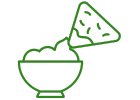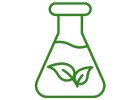Tattoo color - henna powder pro netoxické body art nebo barvení vlasů, 2v1 - 100 g

For your purchase, we will credit you:
+255.25 Kreditů to Bonus programmeWhat is henna
Henna is made from leaves that are harvested from the bushes, dried and ground into powder. The dry powder is mixed into a paste using various substances - mainly something acidic, such as lemon juice, to make the paste sour.
The acid releases from the powder a substance called lawson, which is a dye. When the paste is applied to the skin in samples, lawson combines with the proteins in the skin and leaves stains. These spots represent so-called henna tattoos.
Quality of henna for body art versus quality of henna for hair
Body art henna is more finely sifted than hair henna. This makes the paste smoother, allowing it to flow in finer lines without clogging. Body art henna usually has a higher lawson dye content than the average hair henna - body art henna ranges from 1.5% to 3% lawson dye.
Henna with a lower percentage of lawson dye is suitable for hair, but not for body art.
Each batch of henna powder varies according to its country of origin, lawson content, processing method and even the quality of the harvest in the year it was grown. The lawsone content of henna will be higher if the weather was hotter and drier in the year of harvest.
The quality of henna powder cannot be determined by a mere glance. Different skin types also react differently to henna.
This henna is suitable for so-called tattoo body art, but also for hair dyeing.
Henna with a higher proportion of lawson is a stronger dye.
Pure henna is not diluted by other products, making it stronger. Also, these other products can be very harmful. For example, PPD is sometimes used with powdered henna, especially to produce so-called "black henna"; however, it can cause very serious allergic reactions with long-term effects.
In general, the fresher and purer the henna powder, the better it is for body art.
Preparation of henna paste for body art
The only necessary ingredients of henna paste are henna powder and lemon juice (or other mild acidic liquid). It should be mixed to approximately the consistency of thick yoghurt.
The other ingredients are optional and have different effects on the way the paste works. Many henna artists invent their own unique preparations with a large variety of different ingredients.
Adding something acidic - for henna paste to work, it must be slightly acidic (approximately pH 5.5). The acid releases particles of lawson dye so they can penetrate the skin. Lemon juice or other acidic juices, vinegar, wine or powdered citric acid - anything that will acidify the paste to release the dye - works very well.
After mixing, the henna paste should be covered and left to stand for a while to let the acid do its work and release the lawson particles. When this happens, the surface of the henna turns slightly brown as the dye is released and reacts with the air.
Henna will only dye the skin after this dye release has occurred - if used immediately after making the paste, it will not work.
However, if the paste is left on too long, the released dye may over-react with the oxygen in the air, and thus be consumed and unable to react with the skin. If this happens, the henna will not be able to colour the skin. The paste can be kept in the refrigerator or freezer to prevent this.
The henna paste is affected by the ambient temperature and humidity. On drier days it is more prone to cracking; on cooler days the dye doesn't hold as well. This can be taken into account when selecting the ingredients and timing the dose of henna paste.
Adding sugar - Henna works by staining the skin with lawson dye. The Lawson in henna penetrates the skin and leaves a mark on it, so the longer the paste is left on the skin, the longer the stain has to settle.
Sometimes henna can crack and start to fall off before it completely colours the skin. To avoid this, sugar can be added to the henna paste to make it smoother and less prone to cracking. Sugar also gives henna a more fibrous texture, so you can more easily contour lines.
Honey, fructose, dextrose or other natural sugars can also be used for a similar purpose.
Adding essential oils - Some essential oils will help henna because they contain monoterpene alcohol, a natural plant product. This helps the henna paste to stain the skin faster and also darken faster, as it makes more lawsone available and facilitates faster oxidation.
Only essential oils that contain monoterpene alcohol such as tea tree, lavender, frankincense, geranium, cardamom, cajeput, neroli, pine, rosemary, etc. have this effect.
However, some essential oils have absolutely no effect on henna. Better quality oils are more effective in improving henna. After mixing the oil into the paste, it should be left to rest for a while to give it time to react - at least over an hour, but it can be left with the henna overnight.
Storage
- Powder - if kept in an airtight container, refrigerated and protected from light, henna can last for years. Heat, light and air cause the paint to lose its effectiveness.
- Paste - henna paste lasts a good few days in the fridge. They will last for several months in the freezer. This works because the lower temperature stops the lawson dye from reacting with oxygen; the cool lawson remains in the paste ready to react with the skin.
- Essential oils - should be in dark glass containers, kept out of light and in a cool environment. They lose their potency and effectiveness as a means of darkening henna after the expiration date and generally as they age. The shelf life of different types of oils varies considerably.
Henna body art and hair
Body art henna is excellent for colouring hair because it is finer sifted, so it has a smoother, less gritty texture.
Henna will usually give brown hair a reddish undertone and on grey or light hair it will have more of an orange/red colour.
The resulting colour will depend on your original hair colour, application method and length of exposure.
- On brown hair, it usually adds a reddish-brown undertone.
- On light hair - grey, white or blonde - it adds more of an orange/red tone.
Combination of henna with indigo
to obtain a reddish brown, brown or black shade
When using henna with indigo, various shades of brown to black can be obtained.
The resulting colour depends on the method used, the duration of the application and the ratio of henna and indigo used.
There are two ways:
Method 1
- First, dye your hair with henna to make it chestnut red, and then dye your hair with indigo to turn the chestnut/red color to brown.
- To achieve the desired shade, you need to leave the indigo on for the right amount of time.
- The longer the indigo is left on, the darker it will be.
- If you leave it on for the maximum amount of time, it can turn black.
Method 2
- Soak the henna overnight.
- Just before you want to use the indigo, mix it with water.
- Mix the henna mixture thoroughly with the indigo mixture.
- To get a redder/brown shade, use a higher percentage of henna.
- To get a darker brown, use a higher proportion of indigo.
- To get a black shade, use method 1.
To achieve the desired shade, you have to try and also make mistakes, because everyone's hair is different and accepts colour differently.
Required amount of henna
The following amounts are for normal thick hair:
- short hair - 50 g henna
- shoulder length hair - 100 g henna
- hair length up to mid-waist - 200 g henna
Additional parameters
| Category: | Natural hair colors |
|---|---|
| Certification: | Soil Association Organic |
| Výrobce: | It's Pure Organics, 85 Gregory Road, Mildenhall, Suffolk, IP28 7DF, United Kingdom |
| Země původu: | Velká Británie |
| Vhodné pro: | Vegan-Těhotné-Kojící-Certifikace Bio |
| The item has been sold out… | |
<strong>Contents of the package</strong>
How to prepare It's Pure hair dye
Be the first who will post an article to this item!
Be the first who will post an article to this item!
British brand It's Pure is a sub-brand of Odylique. Introduces natural hair dyes that are made from the purest organic ingredients. The colours are 100% natural, vegan and cruelty free. It is the only hair dye brand that can boast a certificate from the Soil Association Organic. They are of course free of PPD, GMOs, metal contaminants and artificial additives of any kind.

.jpg)












































































